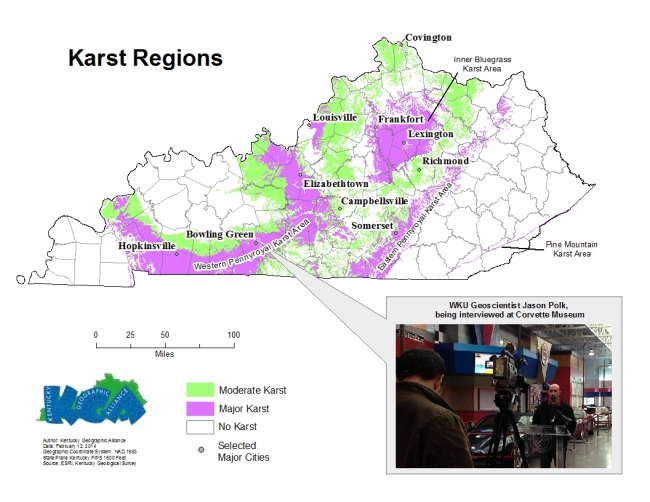Kentucky in the News: Corvette Collapse
On February 12, at the National Corvette Museum located in Bowling Green, KY, a sinkhole caused the collapse of the floor inside the museum’s Skydome. No one was injured in the incident that occurred in the early morning hours, but eight corvettes were damaged as they fell into the sinkhole.
Geography is the study of the physical earth, the distribution of life and resources, and how they all interact with each other. This sinkhole event provides a textbook example of the interaction of Kentuckians with their environment. Geoscientists in WKU’s Department of Geography and Geology study events like this in order to help influence public policy and to understand how we can better interact with and manage our environment.
So what on earth happened here? The karst regions (caves) of Kentucky, outlined in the map above, show where limestone occurs at the surface of the earth. In these areas, water quickly moves underground instead of flowing along the surface as a creek or river. This year’s wet winter has affected the karst landscape in ways that might accelerate sinkhole creation. Those familiar with the geography of much of Kentucky including the Bowling Green area, shouldn’t be overly surprised by such an occurrence. This is because the geography of the area can be described as karstic. In fact, the area stretching in an arc from Hopkinsville to Bowling Green and back north to Elizabethtown lies in a major karst region known as the Western Pennyroyal.
So what is karst and why is it important? Our regional landscape is described as karst as it is characterized by caves, sinkholes, springs, and rolling hills. Mammoth Cave, the longest cave system in the world, is located in Edmonson County and is part of this regional karst landscape. Not only does karst come with the risk of creating hazardous sinkholes, such as this one at the Corvette Museum, but it can also have serious impacts on water movement and drainage. Karst has been linked to some flood prone areas.
Karst is not just located in south-central Kentucky. Other notable major karst areas exist near Somerset (Eastern Pennyroyal) and in and around Lexington/Fayette County (Inner Bluegrass). Indeed, moderate karst areas cover much of western and central Kentucky.
Understanding how we interact with our environment is what geographers do. Scott Dobler, a co-coordinator of the Kentucky Geographic Alliance, will be traveling to Washington, DC, in a few weeks to talk to legislators about geography. Currently, every core academic subject but geography has federal funding. Many challenges that we face today, like globalization (loss of Kentucky jobs to overseas industries), migration at the national level, (Kentuckians moving to other states to find jobs), and environmental change at the local level (sinkhole collapses), have impacts on Kentuckians. Help Scott Dobler support the Teaching Geography Is Fundamental Act by sending a letter to your congressman. It is easier than you think. If you are interested, visit the Speak Up For Geography website.
Please feel free to discuss in the comments below.
Related Links: Louisville Courier-Journal – Bowling Green Daily News – Kentucky Geologic Survey

Recent Comments